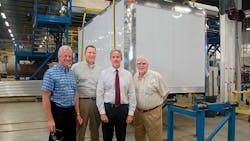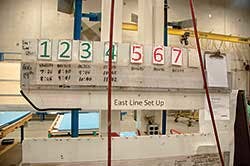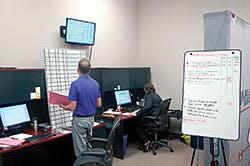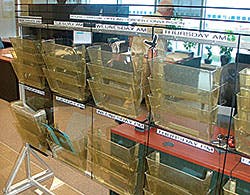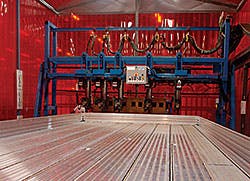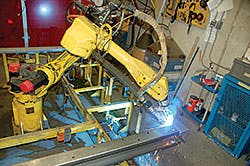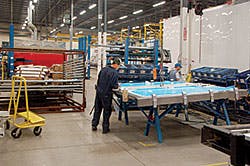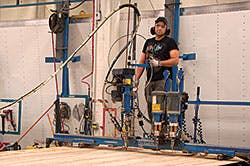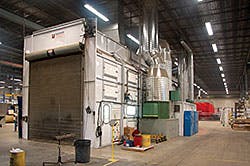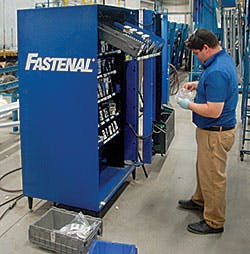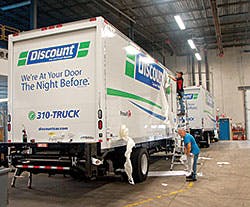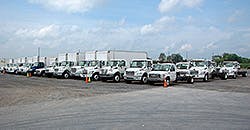Multivans opens new plant to better serve both sides of the border
FOR most of its corporate life, Multivans sold its line of van bodies exclusively in Canada. But with more and more U S van bodies being sold in Canada over the last several years, the Ontario-based company has begun selling south of the border.
And with the strength of the American greenback, Canadian companies once again are very competitive following a period in which the Canadian dollar was at par and even stronger than its American counterpart.
But even without a friendly exchange rate, Multivans management believes that it can compete against larger U S van body manufacturers, especially now that its new 125,000-sq-ft plant is in operation.
“Exchange rates change,” says Fred Seymour, president. “We don’t make permanent commitments based on temporary circumstances. When we decided to open this plant, the Canadian dollar was strong, but we knew we could be competitive in the U S. The more favorable exchange rate makes it easier to compete now.
“We ship product throughout Canada and are reaching into New England, New York, Ohio, Pennsylvania, Indiana, Michigan and even Wisconsin. We see real opportunity in the US, especially those areas closest to us. We estimate the Canadian market for our products at $120 million in annual sales. We believe the US market on the other side of the Great Lakes—but within shipping distance from our plant—is $180 million. Our goal is to double the size of our company through sales into the Great Lakes states. We have a sales rep working out of Buffalo and one just added in Cleveland. We currently have distributors in Syracuse, Rochester, Buffalo and Detroit. We are also doing very well with several regional companies. Our first real opportunity came from one of our largest customers, Penske Truck Leasing. One year when their rental buy was quite small in Canada they realized that the loss of production would be very hard on our company. Their team asked if we could ship into the United States. We said absolutely and never looked back. I remember how grateful we were that Penske had this level of confidence in our company. We are very lucky to have Penske as a long term, strategic partner.”
At one level, the current exchange rate between the U S and Canadian dollars works in favor of Canadian companies who want to sell into the U S. But a high level of U S content in Multivans product erodes that edge, and also had a serious negative financial impact on the company last year. Most Multivans large fleet contracts are negotiated in the late fall and in Canadian dollars. The Canadian dollar lost 20% of its value over the last year.
“Many of our raw materials are sourced in the United States. All of our materials are sourced in North America. Also all base materials are traded in US dollars, including aluminum, steel, and wood. We need to buy many of these products from our U S suppliers and pay in US dollars. So if we are to be successful, we feel that we need to buy and sell in both Canada and in the United States.
Seymour also sees the Great Lakes regional van body market more open to the idea of developing additional suppliers.
“We see resurgence in regional truck body manufacturers across North America,” he says. “In part that’s because some big leasing companies and fleet buyers are reluctant to be tied to only a couple of national sources. They are spreading their orders around. Customers tell us that they would like to see the van body business more competitive. Not just to compete on price and quality, but also on delivery. We can be a player.”
Seymour attributes this trend in part to the fallout from the Great Recession.
“The recession crushed our industry,” he says. “Revenues were off 60%. In the fall of 2007, we hated to answer the phone because there was a good chance that it was a customer calling to cancel an order.
“We survived, but a number of companies didn’t. A lot of capacity in the truck body industry evaporated as a result of the recession. When conditions improved, there wasn’t enough capacity to meet the demand for truck bodies.”
Opening new plant
The decision to open the new plant was made in 2012, and Multivans opened the plant in 2014. The 125,000-sq-ft building is on a 16-acre site. While the company did not design the building from scratch, Multivans found it before it was completed, enabling them to have additional flexibility in the buildout.
Multivans opened this plant for several reasons:
• To gear up for sales growth on both sides of the border.
• To create enough space to allow better material handling.
• To allow one-piece flow in production and achieve better productivity.
• To accommodate future growth. “If you don’t grow, you inevitably shrink,” Seymour says. “We have grown almost 80% from the prerecession levels of 2007.”
• To build refrigerated van bodies.
Multivans has always offered refrigerated van bodies, either its own or serving as a distributor for Kidron. As their overall market share in Canada increased, Multivans devoted more of its manufacturing space to dry-freight vans and relied more on Kidron for reefers.
“Kidron is a great company with an excellent product,” Seymour says. “Our relationship with them dates to before my time. Augmenting our own production with Kidron product was an easy decision. But we became concerned about the effect that a strong U S dollar could have on our sales. While selling their product was relatively easy with our strong Canadian dollar, that could all change quickly. We felt we needed to control our future in the reefer market. Initially we thought that we would build a separate plant to produce reefer bodies and continue to concentrate on dry van production in our old plant. But when this building became available, we decided that having everything under one roof was the way to go. Without efficient reefer body production of our own, the current exchange rate would have put us out of the reefer market.”
Multiple lines
In its current configuration, the plant has two dry van lines and a reefer line. The primary van line runs all year long and the second line really ramps up in the spring to run the large fleet and rental orders.
“The idea is to isolate the big fleet orders without disrupting the rest of the plant,” Seymour says. “We are trying to figure out how to get a fourth line, too—a high option content line.
One of the focal points of the refrigerated van line is the five-head welding system that Multivans acquired from a trailer plant in Alabama. With it, Multivans is able to weld the entire aluminum floor of its truck bodies with just two passes.
Another key feature of the reefer line is the foaming press. The press tilts between 8° and 12° to help the foam expand uniformly. Heated water flows through the walls of the press, keeping the walls between 80° and 85° F to provide an even, controlled temperature—especially in winter. Multivans insulates it bodies with Eccomate foam by Foam Supplies. It is 100% CFC free so it has no impact on the ozone layer. It also produces almost 10 psi on expansion, so the press and all of the fixtures are much stronger that typical. The foam costs more, but eventually everyone will need to use the more environmentally friendly products.”
The fixtures help Multivans address another of its goals.
“We are working to improve the efficiency of our reefer line,” Seymour says. “and we are getting our hours down. Within the next couple of years we should catch our major competitors in the reefer market.”
Robotic welding also helps with productivity in producing dry vans as well as reefers. The company has installed a robotic welding cell that welds 75% of the rear door frames that go on Multivans truck bodies. Seymour says he is pleased with how the robot is performing and will install another to perform other repetitive welding jobs such as bumper production.
Getting leaner
Multivans recently hired a vice president of operations who brings a strong background with lean manufacturing.
“We are a little late implementing lean principles at Multivans,” Seymour says. “but we are pleased with the progress. Last year we were able to improve our productivity between 8% and 9%. We believe we can reach 18% this year.”
Multivans isn’t simply implementing lean in the plant. The company also is putting it to use in the office.
“It’s challenging to apply lean to the office,” Seymour says. “It’s easier in the plant because the process is so visible. You can watch production move down the line, and bottlenecks are easy to identify. Office operations, though, aren’t nearly as visual, and we had to devise ways to detect bottlenecks there, too.
“But how do you implement visual markers in the office? If we are late delivering a truck, 90% of the time it’s because we took a month or more to process and engineer the order. You can’t deliver on time if you are too slow in the front end of the process.
“It’s surprising how many people touch an order. It’s not just the people in the plant. It even includes the customer. We have had to develop ways to help customers think through the process, too. People spend so much time and give so much thought to the chassis and far less time on figuring out what the body should include. And then all the problems come together at the truck body plant.”
Key suppliers
Multivans places considerable value on selecting the right supplier.
“Toronto has almost every industry you need to support truck body manufacturing,” Seymour says. “And if you can’t get it here, you probably can with in the same area in the United States we sell into.
“Materials represent such a major part of truck body manufacturing. We aren’t a big fan of offshore purchasing because we value service from our suppliers. It’s difficult to get good service from a supplier located halfway around the world. That’s why we rely heavily on North American suppliers.
Examples:
• Whiting Door Manufacturing. Multivans’ door supplier delivers each door in racks in the sequence that Multivans will need them. And the company can deliver quickly from their Canadian plant in Burlington, Ontario—45 minutes away.
• Waltco. The liftgate manufacturer has a warehouse 25 minutes away in Mississauga, Ontario. Multivans draws from that warehouse as needed.
• Wabash National. “We use real DuraPlate, and not an Asian import,” Seymour says. “Wabash was great to deal with. They sent a crew here to help us set up our bonding line and train our people.”
• Grote Industries. The lighting manufacturer has a plant about an hour away and ships weekly to the Multivans plant.
• Fastenal. The supplier of plant supplies maintains an inventory on the plant floor. In addition to being a supplier, Fastenal is a Multivans customer. “They have bought truck bodies from us through a leasing company,” Seymour says. “They are a great partner and customer.
• Flooring. “All of our laminated hardwood floors are purchased from mills in Canada,” Seymour says. “We pay a premium over offshore products, but we receive our floors two days before the production date of the body. Try to do that with floors from Malaysia.”
• Metal suppliers. “We work very closely with our key metal fabricators,” Seymour says. “Rear frame components and front wall radius parts are delivered every second day, packaged for specific bodies. Roll-formed sections and aluminum extrusions are also delivered from plants with in an hour of the factory and arrive in weekly shipments.”
Multivans benefits from its location in southern Ontario for several reasons, including the strong manufacturing base that the province has developed. “But as importantly, our local market is one of the top ten markets in North America,” Seymour says. “Most major customers have their head offices or their Canadian headquarters within an hour of our plant. If there is a problem—and they will happen—we can get to the customer and get it resolved.”
Protecting against corrosion
There are also several very good galvanizing companies in the area.
“This is very important to us,” Seymour says. “Canadians understand corrosion. Our climate demands that we do. Much of the steel that goes onto our vans gets galvanized, and it’s nice to have three good companies nearby who can provide that service for us.”
Proper specifications are key.
“We will not use plymetal doors here,” Seymour says. “They just can’t withstand the salt and brine. And we have to make sure that the metal that we do use is well protected. All of our lower bolts are made of stainless steel and protected with isolation washers. We need to make sure that we do a good job of isolating dissimilar metals. Electrolytic corrosion is a problem everywhere, and we do our best to protect against it.”
Helping the industry consolidate
The truck body industry in southern Ontario has consolidated significantly in recent years.
“When we first bought Multivans almost 25 years ago, we had 20 legitimate competitors in our market. Today we have four with factories here and others that ship into the area . The rest either has gone out of business, merged, or were acquired.”
Multivans has helped accelerate that trend. The company acquired a series of companies over the years for multiple reasons, such as to expand the company’s product line, to grow geographically, or to provide greater manufacturing flexibility.
Today Multivans has solidified its presence in southern Ontario as evidenced by its new manufacturing plant. However, it continues to serve areas outside the Toronto area by means of partnerships with distributors in the Maritimes, Ottawa, Quebec, Manitoba and Alberta. Other companies have signed on as authorized repair centers in several smaller markets.
Multivans was started in 1962 by Larry McQuoid and partners. Fred Seymour started his career at a major body builder located in Toronto in 1982. In 1989, Seymour struck a deal with McQuoid to buy out Multivans over time. In 1992, Seymour and Steve Schafer bought the company supported by a group of investors. Two of the original investors have remained on the board and even helped to finance the new factory.
The company has grown considerably since then. The first year that Seymour owned the company, Multivans produced 200 truck bodies. They built 2,200 in 2015.
“We have been very fortunate,” Seymour says. “Multivans has been profitable every year but one in the 24 years that we have owned it.
“Our philosophy is to build a quality product, deliver it on time, and charge a fair price. If we do that, customers will take care of us.
We are blessed with relationships with several key national fleets, Customers that enjoy our relationship as much as we do. Most of our key staff has been with us for many years and we don’t often change suppliers. The key people we deal with don’t change often. When you have that, life is so much easier.” ♦
About the Author
Bruce Sauer
Editor
Bruce Sauer has been writing about the truck trailer, truck body and truck equipment industries since joining Trailer/Body Builders as an associate editor in 1974. During his career at Trailer/Body Builders, he has served as the magazine's managing editor and executive editor before being named editor of the magazine in 1999. He holds a Bachelor of Journalism degree from the University of Texas at Austin.
